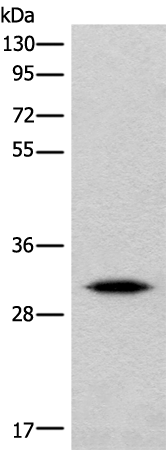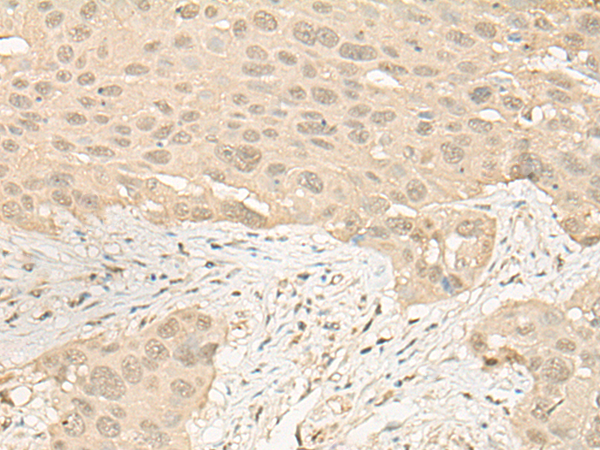


| WB | 咨询技术 | Human,Mouse,Rat |
| IF | 咨询技术 | Human,Mouse,Rat |
| IHC | 1/25-1/100 | Human,Mouse,Rat |
| ICC | 技术咨询 | Human,Mouse,Rat |
| FCM | 咨询技术 | Human,Mouse,Rat |
| Elisa | 1/5000-1/10000 | Human,Mouse,Rat |
| Aliases | IMP; IMPA |
| WB Predicted band size | 30 kDa |
| Host/Isotype | Rabbit IgG |
| Antibody Type | Primary antibody |
| Storage | Store at 4°C short term. Aliquot and store at -20°C long term. Avoid freeze/thaw cycles. |
| Species Reactivity | Human, Mouse, Rat |
| Immunogen | Fusion protein of human IMPA1 |
| Formulation | Purified antibody in PBS with 0.05% sodium azide and 50% glycerol. |
+ +
以下是3-4条关于 **IMPA1抗体** 的模拟参考文献(内容为示例,非真实文献):
---
1. **文献名称**: *"Characterization of IMPA1-Specific Antibodies for Western Blot and Immunohistochemistry Applications"*
**作者**: Smith, J. et al.
**摘要**: 本研究验证了两种IMPA1抗体的特异性,通过Western blot在人类和小鼠脑组织裂解液中检测到约30 kDa的特异性条带。免疫组化实验进一步证实IMPA1在神经元胞质中的高表达,支持其在肌醇代谢通路中的关键作用。
2. **文献名称**: *"IMPA1 Expression in Bipolar Disorder: A Comparative Study Using Antibody-Based Proteomic Analysis"*
**作者**: Cui, Y. & Zhang, L.
**摘要**: 通过ELISA和免疫荧光技术,研究者比较了双相情感障碍患者与健康对照者前额叶皮层中IMPA1蛋白水平的差异。结果显示患者组IMPA1表达显著降低,提示其与锂盐治疗反应相关的分子机制。
3. **文献名称**: *"Development of a Novel Monoclonal Antibody Against IMPA1 for Functional Studies in Neurodevelopmental Models"*
**作者**: Ohnishi, T. et al.
**摘要**: 文章报道了一种新型小鼠单克隆IMPA1抗体的开发,并通过CRISPR敲除细胞系验证其特异性。该抗体成功用于流式细胞术,揭示了IMPA1缺失对神经元分化的影响。
4. **文献名称**: *"IMPA1 Antibody Localization in Mouse Brain: Implications for Inositol Biosynthesis Pathways"*
**作者**: Patel, R. & Williams, K.
**摘要**: 利用免疫组织化学和共聚焦显微镜,研究者绘制了IMPA1在小鼠海马体和皮层中的亚细胞分布图谱,发现其与内质网标记物共定位,为肌醇磷酸酶活性的空间调控提供了新见解。
---
如需真实文献,建议通过 **PubMed** 或 **Google Scholar** 检索关键词(如“IMPA1 antibody validation”或“IMPA1 protein expression”),并筛选近5年高被引研究。
The IMPA1 (Inositol Monophosphatase 1) antibody is a tool used to detect the IMPA1 protein, a key enzyme in the inositol biosynthesis pathway. IMPA1 catalyzes the hydrolysis of inositol monophosphate to free inositol, a critical step in maintaining cellular inositol levels. This enzyme plays a vital role in the phosphatidylinositol (PI) signaling pathway, which regulates processes like neurotransmission, cell growth, and hormone response. IMPA1 is also a target of lithium, a mood stabilizer used in treating bipolar disorder, as lithium inhibits IMPA1 activity, modulating inositol recycling and downstream signaling.
Research on IMPA1 antibodies focuses on understanding its expression, localization, and function in health and disease. These antibodies are widely applied in techniques like Western blotting, immunohistochemistry, and immunofluorescence to study IMPA1 distribution in tissues, particularly the brain, where it is highly expressed. Dysregulation of IMPA1 has been implicated in neuropsychiatric disorders (e.g., bipolar disorder, schizophrenia) and neurodegenerative conditions. Additionally, IMPA1 variants are linked to developmental delays and intellectual disabilities, emphasizing its role in neural function.
Antibodies specific to IMPA1 are validated for species reactivity (e.g., human, mouse, rat) and tested for cross-reactivity to ensure accuracy. They aid in exploring molecular mechanisms of lithium’s therapeutic effects and identifying biomarkers for related diseases. Commercial IMPA1 antibodies are often generated using recombinant proteins or peptide immunogens, with validation via knockout controls or siRNA knockdown. Their utility spans basic research, drug development, and clinical diagnostics.
×